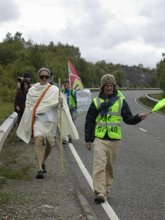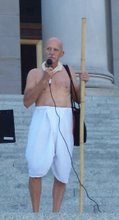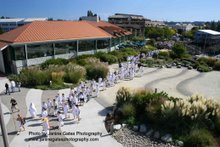Revolution in Egypt, Nonviolence
Gandhi influence and critique
“Gandhi and Nonviolence in the air”
“Gandhi and Nonviolence in the head and in the heart”
February 12, 2011
By Bernie Meyer, “American Gandhi”
The extraordinary 18 days of revolt in Egypt which led to the removal of President Hosni Mubarak and the promise by the Military Council replacing him to have elections and democratic reforms warrants reflection and analysis. This is such a surprising development that only time and revelations about the lead up to the revolt, its playing out and conclusion will give a much more complete picture. Of course, only time will tell how authentic and meaningful the reforms will be. Just over 30 hours have passed since a President Mubarak has resigned and left the scene. The jubilation and exultation are still at a high pitch.
I am making this reflection about the influence of Gandhi on the nonviolent nature of the revolution as an activist for justice and peace and as one who has been portraying Gandhi for the last nine years in the United States, Canada, the UK, and especially India. I have been continually studying the life and the “experiments” with truth of the historic Gandhi. I attempt to understand his efforts and principles, his experiences, his culture and heritage, his effect upon India, the British Empire, and the world.
Most important for me is Gandhi’s influence on the issues today. What are the lasting effects, not just on India, but on the movements and nations of the world? I believe that it is inadequate to merely study Gandhi’s life and read the 100 volumes of his writings, and the numerous volumes about him. I see my efforts as a continuation of his experiments with truth. I encourage everyone to do the same.
The surprising and amazing nonviolent revolution in Egypt beginning January 25th, 2011 demands in my mind a thoughtful assessment of Gandhi’s influence. This essay is only a beginning. We do not know much about the details of events and constituents leading up to the 18 day revolt. For myself, I have not been a student of Egypt. My knowledge is but an outline of the events over the last sixty years and a sense about the Mubarak regime and its predecessors of recent memory, especially the second and third presidents Gamel Abdel Nasser and Anwar Sadat, the confrontation with the British and French over the Suez Canal and the war with Israel in 1967. The Egypt of the Pharaohs going back 4500 years is a marvel of “civilizations.” Egypt’s culture today is a result, but one affected by modernity in very significant ways. When looking at Gandhi’s influence, I can only say that India today has not gone the way of Gandhi. Modern India is more Western than Eastern in terms of technology, economics, and probably politics. Nonetheless, India has its Gandhians and its nonviolent movements. Gandhi is in the air. Gandhi is also in the hearts and minds of many Indians. I cannot but believe that he is also in the air, as well as in hearts and minds of Egyptians.
While positing this position, I have more questions than answers. What led the young men and women who joined together with twitter and facebook to begin with nonviolent protests? Why did the workers who joined them in coalition adapt the same nonviolent posture? Or, was it the other way around? Or, was it a mutual decision? And, they claimed that there is no one leader, but that all were leaders and responsible. Gandhi went through rigorous personal “purification” and self-training. Gandhi spent years preparing the Indian National Congress and the people for the various campaigns for independence. The Civil Rights movement in the United States began long before Martin Luther King Jr arrived on the scene. Even then, training and preparation for the campaigns and actions was standard and necessary. So, what training and preparation did the Egyptian participants have for the last 18 days of action?
Friday, February 18, 2011 I am inserting here information due to yesterdays New York Times front page article about Gene Sharp’s influence on the Egyptian revolt, “Shy U.S. Intellectual Created Playbook Used in a Revolution.” Sharp studied Gandhi’s methods along with those used in several nonviolent protests and revolutions. He has published several volumes considered prime resources to movements fighting for human rights, oppression, and democracy. The Times article describes how the April 6th Movement, 2006 in Egypt, found Sharp while seeking help, how Peter Ackerman trained Egyptian’s in 2007 using Sharp’s methods, and how the trainees learned the strategy and actions helped both the recent Egyptian and Tunisian revolts. Sharp comments about the Egyptian lack of fear, “That is straight out of Gandhi.” “If people are not afraid of dictatorship, that dictatorship is in big trouble.”
As I followed the daily developments in the alternative media (I have no television.), the press, and local gatherings, I observed a continuous set of developments. Each day required new actions. Each day, it seemed, meant an injection of additional energy and commitment. The momentum built up incessantly from beginning to end. And, the actions were disciplined.
At the beginning there were the burning buildings of the hated police and destruction of some property during the street confrontations. The police disappeared rather quickly. Then, the reactionaries came on camels and horses to attempt beating and intimidating the participants into submission. That too was short lived, although 300 and more died during the period and thousands were injured. At each stage more people came out to join in, the numbers increased. A moving moment occurred when Wael Ghonim was released from twelve days in jail. His televised testimony stirred the people. He said that Gandhi moved him and admitted that he felt positive moments with some of his interrogators. The segments of society participating grew as the drama unfolded. Toward the end, doctors and nurses walked together to visibly support the demands and meaning of the revolutionaries, followed by the lawyers in unison.
Middle class folks who had comfortable and secure lives also took the risks. I read about a middle class mother with two young daughters who said that she left her home with the idea that she wanted to support this movement for critical change. She not only offered support. She said that if she should die, even if her daughters should die by participating, the sacrifice would be necessary and worth it. Major changes like this movement in Egypt cannot be made without sacrifice.
How did these attitudes come about and develop? No doubt those 30 years of harsh rule gave many opportunities for consciousness raising -- despite government propaganda to the contrary. People must have spent time thinking and talking about repressive and abusive events. The state run media was unable to completely fool the population. Again, as the days and related events unfolded, as the escalation of government repression, propaganda, seeming concessions to the demands, and Mubarak’s refusal to resign occurred, more people and new constituencies came forward. It appears that the majority population was “like-minded” with the folk’s in the streets.
In these situations it is imperative that the revolt’s objectives be clearly identified. The demands for Mubarek’s resignation and for elections of a democratically elected government, and related reforms (no doubt also an end to police repression and brutality) were consistently before everyone, including myself watching with my internet sources. The people were not fooled by Mubarek’s apparent concessions. They would not trust him nor his chosen designee, the newly appointed Omar Soleiman.
Back to the organization, strategy, communications, etc of the events and developments over the 18 days, how did these hold together? Surely, twitter and Facebook communications alone by hundreds of thousands of people did not account for the consistency and clarity we observed. I do not have an answer to the particulars. But, the reporter I observed daily on Democracy Now! made it clear that there was a group who was steering the direction and course. I am sure we will learn more in time.
The commitment to nonviolence is the wonder. As Gandhi often said during his campaign for independence, the power and methods of nonviolence will grow in unimagined ways in the years ahead. In the Middle East where suicide bombings and all sorts of violent attacks appear to be the main way to respond to governmental oppression, ethnic division and competition, including US and Western war making and power moves, Egypt found and chose a different way. (The Tunisia revolutionaries did the same thing.)
Gandhi’s objective in satyagraha (truth force), ahimsa (nonviolence), and tapasya (suffering and commitment) was to come to a resolution to conflict which was mutually beneficial to the opponents. The ideal is a dignified result for each opponent, where each could walk away with head held high and continue in like relationship if desired. Gandhi’s goal was neither to embarrass nor to defeat the opponent. Obviously, in Egypt Mubarak and his cohorts were defeated. The government is now controlled by The Supreme Council of the Armed Forces. The military has ultimately controlled the government since the 1950’s. The question now is, will the military hold true to its statements of reform, democracy, and elections in the months and years ahead?
The military is a core question in itself. During the campaign of the last 18 days, the military was visibly present. For the most part the visibility was from tolerant to supportive of the people. After Mubarek’s departure, the military in the streets took part in the celebrations. There is an obvious rapport between the people and the military, at least on the rank and file level.
However, there are more than reports about people being tortured and abused. Elements of the military were responsible for these. And, for people like me who are aware about renditions by the United States military and intelligence agencies to Egypt, the torture executed was done by military elements. Suleiman, whom Mubarak appointed Vice President during the revolt, was former Chief of the Egyptian General Intelligence Services (EGIS). (We in the US movement who have participated and followed the 20 plus year resistance by the School of the Americas Watch know that the US has been training foreign military and paramilitary personnel in oppressive measures at least since World War II.)
Second, the leadership of the Egyptian military is well entrenched and Mubarak had a nearly 30 year tenure in office to appoint and foster leadership with an antidemocratic mentality. Will the coming months see a transformation of this repressive mindset?
Finally, I must name the relationship of the United States and Israel to Egypt. The US has strong, critically strong, interests in the Middle East. Egypt is a major and needed player for the United States and Israel. The United States invests billions of dollars yearly in Egypt. Most of that treasure goes to the military. President Obama played a cautious hand during the last few weeks. He did not come right out and support the people. While the US purportedly supports democracy, it must be a democracy that allows the interests, and not just the security interests, of the United States and its allies to be achieved.
Will the Egyptian democratic government happen? Will that set a tone for more democratic governments to arise in other Middle East nations? Will these set a new approach to social change through nonviolence and an end to the dominant paradigm of terror? There is change occurring. (I viewed the documentary, Budrus, the other evening about a West Bank Palestinian village which made nonviolence work in moving Israel to reposition the “Wall” away from the village. Nonviolence is being tried more and more.) Nonviolence (Gandhi’s way) is in the air. Nonviolence is in the hearts and minds of many people.
Another observation about Gandhi and his methods and vision is swaraj and civilization. I must clearly state that Gandhi espoused and dedicated himself to a more fundamental reality than satyagraha. He called this his “constructive program” which he centered in the villages of India. From the bottom of Indian society the individual lives by swaraj (disciplined self direction with duty to the community) and participates in village life for the good of all. The village in turn expresses swaraj to other villages. Gandhi’s vision was that swaraj envelop, more impregnate, the world. Gandhi’s core vision was expressed in his inspired piece, Hind Swaraj. For Gandhi, true civilization is one of this nature, rooted in swaraj. Egypt was a great civilization. With Gandhi, I think that in the evolution of humanity, great civilizations will not be built with slaves and oppression, but with dignified local communities among world democracies.
As a corollary to this piece, I want to name the daunting challenges that underlie all the realities that we are discussing. No matter who governs or how they govern, in the words and book by Lester Brown, we live in a WORLD ON THE EDGE, How to Prevent Environmental and Economic Collapse. Egypt and the area of the Middle East are very much on the edge. Here are key factors about Egypt:
Population 1960: 27.8 million
Populaton 2008: 81.7 million
Current population growth rate: 2 % per annum (a 35 year doubling rate)
Population in 2046 after another doubling: 164 million
Rainfall average over whole country: ~2 inches per year
Highest rainfall region: Alexandria, 7.9 inches per year
Arable land (almost entirely in the Nile Valley): 3 %
Arable land per capita: 0.04 Ha (400 m2)
Arable land per capita in 2043: 0.02 Ha
Food imports: 40 % of requirements
Grain imports: 60% of requirements
Net oil exports: Began falling in 1997, went negative in 2007
Oil production peaked in 1996
Cost of oil rising steeply
Cost of oil and food tightly linked
Posted by Chris Martenson, Feb 10, 2011, “Egypt’s Warning: Are You Listening? http://www.postcarbon.org/blog-post/250866-egypt-s-warning-are-you-listening I recommend reading the blog to see the elaboration of these figures.
These conditions pre-existed the revolution and continue after the revolution. They challenge not only the goal of democracy, but the very existence of government of the state called Egypt. Will the peoples living in this land of ancient civilization be able to develop a sustainable way of life?
Now on February 22, 2011 I add another significant input about the revolt by Stephen Zunes who posted an article in Truthout on February 17th: “Credit the Egyptian People for the Egyptian Revolution.” This excellent broad analysis does not mention Gandhi or Gandhi’s possible influence, but validates many of my observations and fills in important answers to my questions. Nonviolence indeed has been “in the air” in the Middle East and in Egypt for decades. Zunes points out that nonviolence was chosen in many situations, not for political nor for spiritual reasons, but because “it works.”
Here are two summary observations by Zunes:
“It is critical, particularly for those of us in the United States and other Western countries, not to deny agency to an Arab people who had the courage and smarts to organize and fight their own nonviolent revolutions.” Zunes then goes on to state that “the revolution strikes a blow” to the two extremes, Al Qaeda and the American neoconservatives.
The last paragraph of the article summarizes: “This rich history, mostly dramatically played out on the streets of Cairo and other Egyptian cities in recent weeks, demonstrates a critical point: Democracy will not come to the Middle East through foreign intervention, sanctimonious statements from Washington, voluntary reforms by autocrats, or armed struggle by a self-selected vanguard. It will only come through the power of massive non-cooperation with illegitimate authority and the strategic application of nonviolent action by Middle Eastern peoples themselves.” http.//www.truth-out.org/credit-egyptian-people-egyptian-revolution67850
www.oly-wa.us/berniemeyer
www.americangandhi.blogspot.com







